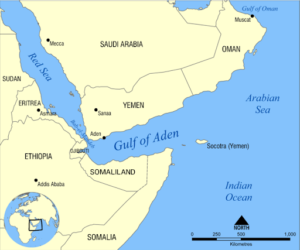
Key Points:
- Location: The Gulf of Aden is situated in the Arabian Sea, positioned between Yemen on the Arabian Peninsula’s southern coast and Somalia and Djibouti in Africa.
- Orientation: It extends in a west-east direction, serving as a natural maritime link between the Red Sea and the Arabian Sea.
Strategic Importance:
- Connection to Red Sea: The Gulf of Aden is connected to the Red Sea through the Bab el Mandeb straits, a critical chokepoint in global maritime trade.
- Maritime Traffic: This gulf is a vital corridor for ships traveling to and from the Suez Canal, making it a key transit route for global shipping and trade.
Economic Significance:
- Fishing Industry: While the Gulf of Aden’s coastline is not equipped with large-scale fishing facilities, it supports numerous small fishing towns contributing to the local economy.
- Major Ports: The gulf hosts significant ports like Aden in Yemen and Djibouti in the Horn of Africa. These ports play a crucial role in regional trade and logistics.
- International Trade: Due to its strategic location, the Gulf of Aden is pivotal for the transportation of oil, commercial goods, and other maritime trade between Europe, the Middle East, and Asia.
Security Concerns:
- The region has been known for piracy and maritime security threats, particularly off the Somali coast, impacting international shipping and naval operations.
Why in News:
- Recently, Indian Navy’s destroyer INS Visakhapatnam responded to a distress call from drone-hit merchant vessel in Gulf of Aden.
 Profile
Profile Settings
Settings Refer your friends
Refer your friends Sign out
Sign out





